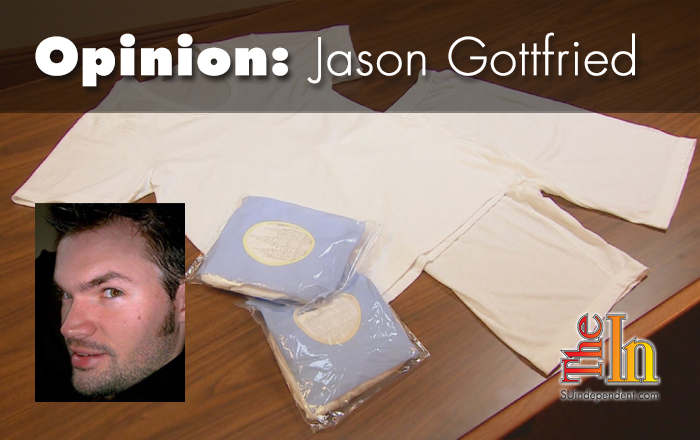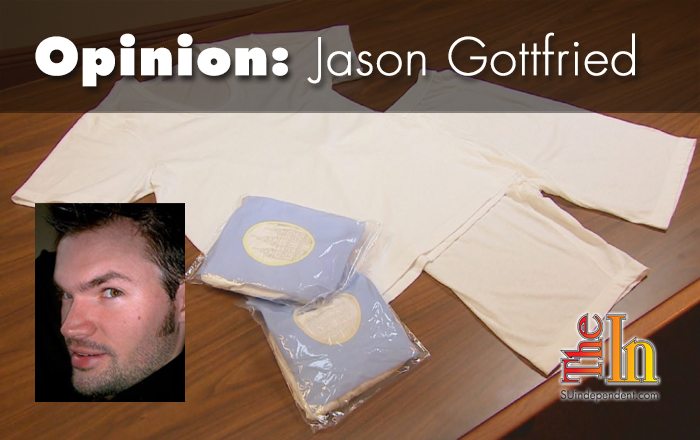
Dr. G’s point about unethical conduct was illustrated best by her attackers
Recently, The Independent ran an installment of Gretchen Lambert’s column, “Dr. G Hits the Spot” entitled, “Neither integrity nor undies always make the man.” Racy name, huh? (You can read that article here.) In the repressive social atmosphere of southern Utah, this column “goes there,” with titles ranging from “Is three really a crowd?” to “STDs in STG.” Her article is styled after “Dear Abby,” in which a supposed writer asks a question which the article proceeds to address.
In this recent article’s introductory letter, a situation was described wherein a Mormon who was wearing temple undergarments tried to initiate extramarital sex, and the writer expressed her feelings of outrage. This was likely a fictional scenario, but people are only human, and it seems unrealistic to imagine that what was described has never happened.
Accompanying the article was an image of two people modeling temple undergarments. It’s pretty neutral and unprovocative. The photo accompanying the article was a picture taken from Wikipedia. It is a public domain image, which means that anyone can use it for any purpose—there are no copyright issues.
Now check out this piece’s lead image. Is that offensive? Disrespectful? Blasphemous? It looks like underwear to me. What is the secret ingredient that makes posting a picture of this clothing so horrendous? This image was posted online by ldschurchtemples.com. Seems like they’re okay with it being online.
It’s no surprise that the image was released to Wikipedia by Richard Packham, a Mormon-turned-atheist and outspoken critic of the LDS church. He maintains a website of his writings on Christianity, Mormonism, and the Bible in addition to book reviews and recipes.
The backlash to this article’s publication was intense and immediate. It prompted a deluge of inflammatory commentary from members of the LDS community who were outraged, demanding that the picture be taken down. It was “disrespectful,” “tasteless,” “offensive,” and “vulgar.” Vulgar! Meanwhile, Lambert was the only person who actually created any original content. I don’t think that she should have caught any flak for that, but one would think that more ire would have been directed at the content than this old photo that’s been drifting around online for who knows how long.
The article neither mocked the underwear nor the practice of wearing it, nor the church that has implemented the undergarments’ use.
I respect and would defend any person’s right to practice their religion to the extent that it doesn’t harm others, and voluntarily choosing to wear temple undergarments is a pretty innocuous practice. My Mormon friends and neighbors, who are kind and compassionate people, have every right to uphold this practice, and I celebrate the fact that in this nation they can.
However, were I to choose such a practice, I can’t imagine not feeling self-confident about it if I really believed in it. Frankly, even if someone teased me, I’d have to just let it roll off my back, knowing that I was secure in my belief. If you’re right, you’re right … right? As such, I have trouble understanding why publishing a public domain photo of those undergarments—when the LDS church itself has put pictures of them online for the public to view—is even an issue worth commenting on at all.
Here’s the thing: if it’s not a secret, it can’t be “exposed.” It’s already out there. Anyone who is mad about the picture ought to be clamoring about Wikipedia having made it public. Google “Mormon underwear,” and tell me that what was published in Lambert’s piece is not on the conservative and respectful end of what you see.
The other issue is this: if it’s not a shameful practice, who cares if someone publishes a picture of it? It’s underwear. It is literally underwear. I don’t mean to trivialize the significance of the underwear at all. But it’s fabric, mere clothing, and a published image of it doesn’t demean it, degrade it, or debase it.
So how was republishing that already-once-published photo disrespectful?
Had the article been about how temple undergarments are stupid and how people who wear them are stupid, I think there would have been a pretty justifiable public outcry from Mormons and non-Mormons alike.
But it wasn’t about that at all.
What was most interesting was reading the more threatening comments and then thinking to myself, “Gosh, these people claim to be followers of Jesus Christ.” I can’t understand how threatening someone in any way is Christian behavior—Christ having been a notorious pacifist—and I don’t see how those individuals thought that they were representing their church in a positive light. Regardless of their intentions, their behavior was purely destructive.
Surely we all know the story of Jesus’ arrest in the synoptic Gospels. When in defense of his beloved teacher Simon Peter attacked a soldier, severing his ear, Jesus healed the soldier and immediately reprimanded Simon Peter. To draw a parallel, if someone had published a picture of Jesus’ undergarments and held them up, one might imagine Simon Peter becoming defensive—and, in turn, going on the offensive—and attacking that person. How do you think Jesus would have reacted to that situation?
There are a lot of Mormons in southern Utah, but this is still America, and we’re not all Mormon. When any group reacts to any situation with this level of vitriol and aggression, how do you think that group appears to the rest of the world? Do you think that they come across as loving? Do you think they make effective emissaries of Christ?
It is not the job of the press to be “tasteful.” What is considered to be tasteful is subjective; obviously, there are things that are pretty glaringly obvious, but to singlemindedly pursue “tasteful” publication above all other concerns would be—to quote Ecclesiastes—like chasing the wind.
Ultimately, Lambert’s article’s point—which she used a hypothetical example to illustrate—is that there are various codes of ethical conduct, and she pointed out that the Mormons have their own. (She said it in the context of the Mafia having their own as well, yet no one said a word.) Ironically, with the torrent of acidic commentary directed toward her, they broke their own code. As they harangued and harassed Lambert and The Independent for being “disrespectful,” that’s exactly what they were. This community owes Lambert a sincere apology




